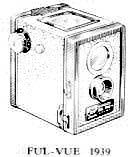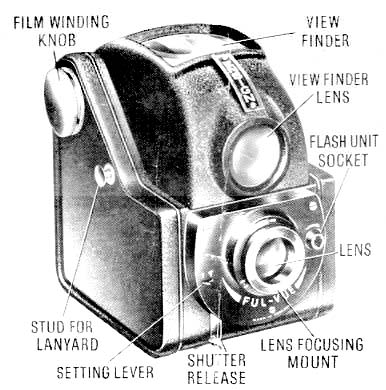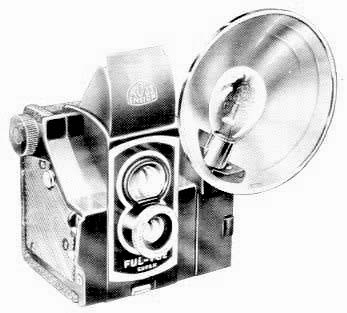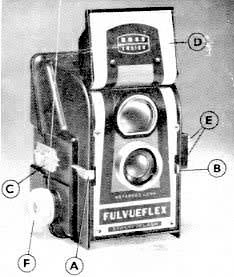
The Ensign Ful Vue
Early in 1939, Ensign Ltd. introduced what was to become one of Britain's most popular cameras. Fondly remembered by many photographers as their first camera, often bought for them by their parents while they were still children. The Ensign Ful-Vue was a design which immediately captured the publics interest, an interest that has lasted even until today as this is still camera that is widely collected, regarded by many as a design classic.

Originally designed in the Bauhaus tradition of 'form follows function' the first Ful-Vue was a simple pressed steel box camera with a crystalline enamel finish. Its large reflex view finder gave, according to Ensign, "... a better idea than ever before of what the finished result is likely to be,.." It was equipped with the patent Ensign 'all distance lens' which enabled close-up photography down to a distance of 3 feet by means of a pull out lens mount and had a simple I.T shutter. The camera was designed to give one picture size of 6 x 6cm allowing for 12 pictures on a 120 roll film, because of this only one viewfinder was necessary and the small picture size gave more room at the top of the camera body, enabling a larger view finder to be built with a lens of almost an inch in diameter. This gave the camera one of the brightest view finders of the time, better even than some of the more expensive reflex cameras available. Interestingly the mirror for the view finder was not made of mirrored glass but a polished metal plate secured by two screws on either side. If you consider the price of mirroring glass compared to chroming a sheet of metal then cutting it up, this was probably a more economical method of producing a mirror. In addition a metal plate does not crack when dropped, adding greatly to the ruggedness of its design.
The end of the war in Europe and later the Far East prompted a
backlash against the austerity of war time Britain and a wish by
the general public to move forward into a prosperous and brighter
future. In an attempt to show the public the way "from war
to peace" Sir Stafford Cripps, president of the Board of
Trade, proposed that an exhibition of British products should be
arranged to show the public what manufacturers could achieve in
post war Britain. Cripps instructed the Council of Industrial
Design to organise the exhibition and they in turn approached
manufacturers requesting them to exhibit designs for new and
futuristic products. The exhibition was called 'Britain can make
it' and was held at the Victoria and Albert Museum, which at that
time was empty. Barnet Ensign Ltd. responded by exhibiting two
new cameras the Ensign Commando and a completely redesigned Ful-Vue.

The design of the new Ful-Vue is worth special comment, not
only did Ensign abandon the conventional box shape for this
camera but they utilised many of the new fashions in design to
produce a very modern looking product. This was a camera
specifically designed for aesthetic appeal fully embracing the
principals of streamlining as suggested by the American designer
Harold van Doren in his book 'Streamlining in Industrial design'
of 1940. To gauge the success of their new product Ensign offered
pre production models of the Ful-Vue to its staff at half price.
Reactions varied to the new introduction, "some felt the
camera to be revolutionary others that it was so completely
different that it wouldn't sell". however all agreed that
"it was a comfortable camera to handle because of the big
view finder". The publics endorsement was enthusiastic and
the camera sold in thousands.
An improved model was introduced in 1950, dubbed the Ful-Vue
II. It had an all plastic front panel housing a new shutter
assembly which for the first time provided the camera with a
flash synch terminal. Initially it was fitted with Ensigns own
bayonet synch plug later being replaced by the compur co-axial
type. The lens was also improved, the 'all distance' lens that
had been with the camera from the beginning, was now replaced by
a three point focusing lens. Unfortunately the accuracy of the
distance markings left much to be desired making focusing a
rather hit and miss affair.
1951 saw the introduction of a flash for the Ful-Vue. A simple
unit consisting of a cylindrical battery holder with a reflector
attached. The entire assembly was fitted to the camera with a cam
operated clamp. It could be fired in two ways, either by
connecting the synch lead to the flash terminal of the cameras
shutter or for earlier cameras without a flash synch terminal
Ensign provided a manual firing button. (see photo) This was
little more than two contact strips of chromium plated metal that
when squeezed completed a circuit firing the flash bulb. The
camera shutter needed to be set for a time exposure for this
operation. In 1953 Ensign introduced coloured versions of the
camera to mark the coronation celebrations, one camera dealer
remembers dressing his shop window with coloured Ful-Vue's and
the union flag for the celebrations. Called Ful-Vue "a la
mode" they came in red, white and blue, very patriotic, and
were advertised as fashion accessories. A clear plastic case came
with the camera presumably to allow others to admire your
matching handbag and camera.
In the B.J.A. of 1954 Ross Ensign, as the company was now
called, announced a new introduction for that year, the Ful-Vue
Super. Replacing the Ful-Vue II, which they claim had sold over a
million units. The super was similar in appearance to the earlier
model but with slightly more angular lines and a hood for the
view finder made out of steel onto which was emblazoned the Ross
Ensign trade mark. The camera back was also of pressed steel and
could be completely removed for film loading. A swing out cradle
was also incorporated into the camera greatly improving the ease
of loading and eliminating one of the major criticisms with
previous cameras. The camera body was no longer made of pressed
steel but cast alloy. The main body and view finder housing now
being two castings joined in the middle and held together by tie
bars screwed at either end. The shutter was integral to the body
and the flash synch terminals were now threaded pins used to
mount the flash unit onto the camera, similar in design to the
flash holder made for Brownie flash cameras by Kodak. Within the
year a flash holder was released to accompany the camera. The
most significant change was however the switch to 620 roll film.
This seems to have been Ross Ensign policy on their cheaper
cameras both the Snapper and the Clubman, contemporaries of the
Ful-Vue Super, used 620 roll film. Strangely no write up appeared
in the B.J.A. for the Ful-Vue Super as it had for the earlier
models even though this was a much improved design. Design was
once again used as a selling point with this camera. Advertised
in the Ross Ensign catalogue of June 1954 as being developed from;
" Improvements suggested by the manufacture of over a
million earlier Ful-Vue cameras....."

The final chapter in the Ful-Vue story came with the Fulvueflex Synchroflash. Although it carried the Ross Ensign badge it was a cheap plastic camera and a total departure from the sturdy tradition of Ensign cameras to date. Their is little known about this camera and no adverts are to be found, it is assumed that this model was introduced towards the end of Ross Ensigns trading around 1957.

This camera was larger than the Ful-Vue Super and used 120
roll film rather than 620. The Fulvueflex instruction book shows
some accessories that were available for the camera, an ever ready
case, a sports finder attachment and a bulb flash unit. A mystery
surrounds this camera. Why did Ensign run the Fulvueflex
alongside the Ful-Vue Super and why did they suddenly switch to
plastic for this camera? It would surely have been prohibitively
expensive to invest in new injection moulding equipment. In my
opinion it is more likely that production of this camera was
contracted out to another company in an attempt to cut costs. If
as I suspect this was the case Ensign may have been successful in
cutting costs but the camera was not a success itself. It did
sell but not in great numbers probably because the camera was
poorly constructed and had a cheap feel. With no new quality
products the company went out of business a couple of years later
bringing the Ful-Vue's 20 year run to an end.
Ful-Vue Chronology |
||
Model |
Date Introduced |
Date Discontinued |
Box Ful-Vue |
1939 |
1943c |
Streamlined Ful-Vue |
1946 |
1949 |
Ful-Vue II |
1950 |
1953 |
Ful-Vue Super |
1954 |
1959c |
Fulvueflex Synchroflash |
1957 |
1959c |
c=circa |
© Copyright Adrian Richmond 1999. All rights reserved.